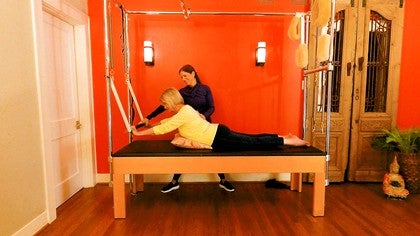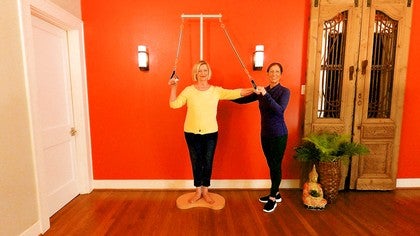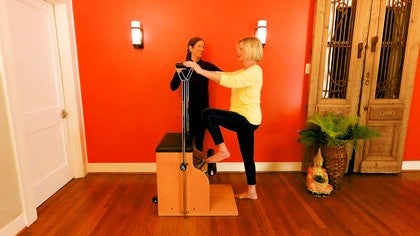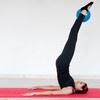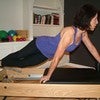Description
About This Video
Transcript
Read Full Transcript
Now we'll begin working with Peggy, addressing her thoracic kyphosis and forward head posture and trying to improve her thoracic mobility and strength using the trapeze table. All right, so Peggy, if you'll step up on the box, and hold on to the bar here, and then reach up for the little, non-skid pads, I always put those on there because it's really sweaty to hold those bars. Now, I want you to do shoulder shrugs for me. Okay, so now pull up and pull your shoulders down. That's it, and then release, and then pull up.
That's right, spine goes up, shoulders go down, reaching up. This is such a great way to work with shoulder mobility, impingement of the shoulder and thoracic extension. Certainly some lengthening here, you can imagine that rib the pelvis distance improving, that looks great. Now hold that and I want you to kick out with your left leg out to the side. One, two, three, four, keep your shoulders down as you do that.
five, all right, five on the other side, one, two, kind of down and back, that's it, three, four, and five. Yes, that abduction helps to improve that length even more, now really slowly coming down. Great. Now she's five foot six, right? Okay, go ahead and hold on to the bar, and then step down.
Okay, now we're gonna have you sit on the table here, and let me get this out of the way. And I'm gonna have you lie down on your back. Yes, great, and I always make sure that they don't need any prop for the head. And it looks like she's doing a great job there with relaxed posture, come to the center of the table, excellent. So I want you to hold on to this bar here.
And then bring your hands to the width of the bar, and then push overhead. So it's very similar to what she just did. And now I'm gonna have you draw your shoulders down towards your waist, and then back up again, arms straight. So this exercise is always inspired by Deborah lesson. And I think of her every time I do this exercise, I used to call it and Club Deb.
And she was such a wonderful mentor for me. All right, and take the shoulder up, shoulders up, keep the elbows straight. So I'm really trying to keep her shoulder blades moving and not the elbows. So don't bend your elbows, gonna keep them straight. Yes, that's better.
I try to save my don'ts for emergencies. That's it. Good job, all right, now you can just bring the bar overhead and then release the bar, okay, just let go. That's it, bring your hands down by your side. Okay, now I'm gonna grab some loops.
So the first loops that we're gonna use are these COVID friendly loops that were developed by Balanced Body that are vital and easily cleaned between patients. And then I have some double loops that we'll be using here too, that will need to be washed between sessions. So, all right, so we're gonna put this one on first. And I want you to put your right foot in the loop. And I'm gonna make sure that she has some peripheral neuropathy and foot pain, making sure that feels okay to her.
And then I want you to just to lengthen that leg out. Uh huh, and then press it down to the table. That's great. Take it up, keeping the knees straight, and then press down. Excellent, so we're trying to improve her hamstring length.
And the interesting thing about this exercise is that, what does this have to do with thoracic kyphosis, right? What it has to do with thoracic kyphosis is as she pushes the leg down, she presses into her head and her back. So when you tuck your chin and press your head down, she probably didn't realize that she was doing that. But you can feel that when you press your head down, right. Okay, now we're gonna take the leg across the body.
Now this is gonna be like a sciatic nerve glide, because the sciatic nerve is lengthened in this position, and I wanna have her circle and try to go down as far as you can. That looks really good. You're doing a great job keeping your leg straight. If the leg is bent, it doesn't actually floss the sciatic nerve. So because she has the neuropathy, I wanna really keep that nerve healthy and flowing and it's pathway.
That looks great, one more time, and release, very good. All right, now I'm gonna come around and we're gonna do the other side. Okay, left leg in the loop, keeping your toe pointed as much as possible. And I really work through that little hammer toe there, I wanna get it to point. And then I want you just to go straight up and down on this first set, reaching long, hinging at the hips.
That looks great, progressing down and up. All right, I'm gonna go ahead and add something that I really like to add for coordination and for your mobility. So placing your hands on the tower bar. And I want you to push the bar over your head and just keep it there for a moment, push the leg down straight. That'll stretch you out really nicely, and that's gonna feel good, you're gonna feel like a new person.
All right, now progress and lengthen. Beautiful, you can really see that waistline stretch. And then we're gonna add a little coordination component by having her bend her arms and press up toward the ceiling. So bend your arms, push the bar toward the ceiling, coming through like that. So you have to make sure the bar is high enough that it doesn't clip their head right, push down.
And we noticed that I don't have any springs on the bar, there's no need to put the springs because I'm not really working on strength or her scapula right now, I'm just working on some coordination and shoulder mobility, progressing the foot down as the arms go up, and bend to come in, breathing in, breathe out to take the arms overhead. Great. So you see how I layer on the complexity, right. And then one more, stretching out. So we get the foot going first, and we do the arms.
And then we combine it all with breathing. Okay, bend your arms and let the bar go overhead. And then place your hands by your side, we're gonna do the flossing of your sciatic nerve now. So now take it around, and come up. And let me know if that's painful at all.
as you go around, that's actually better. It's okay. Where do you feel it? Along the side of that. Along the side of her leg and calf.
So we're gonna do a little bit more with that in just a moment. That looks great. Pressing down and around, excellent. One more, exhale, press down and up and around. All right, well, really well done, you did a great job keeping your knees straight.
That is sometimes been a problem for her, she's had a hard time keeping that knee straight. So we're gonna do something different here with the double loops. And I just wanna show you in some cases, she has had some cramping in that foot, and we've had to switch to the double loops, because keeping that toe pointed not arch lifted for a long time has been difficult. And so I'm gonna put the double loop on there. So that she doesn't have to worry about keeping the toe pointed.
So let's take this leg up. And this can add that additional flossing component to the sciatic nerve. So I'm gonna have her flex her foot, take it down, straight knee, like that, and then point to go up. So in this case, she can flex the foot and not have to worry about the strap coming off of her foot. Good, all right, now take the leg across the body.
And now I want you to circle your foot. Uh huh, so as she circles downward stop here, in that sickling position, that's gonna give her the greatest stretch to the coronial portion of that nerve. And so you might feel a little more intensity there, right? That's it. So if you do that as you go around, take it up and across, and then flex this foot down, just like that.
Great, I love that, all right. So that's something that you would normally do on both sides, but we'll just do it on one side for today. And move on to the next exercise. So I'd like you to turn to your side. So remember, I cue you every time you make a transition.
So no, you're not coming out, you're gonna turn to your side. I just roll over? That's right, and then sit up, bring your legs over and then sit up. So I don't want her to roll up and forward because that would be compressive to the thoracic spine. So you roll to your side before you sit up right.
Okay, now I'm gonna take a minute here while she's resting and I'm gonna move the bar down because the next few exercises with the tower bar are gonna require that the bar remain downward. This is always a challenge to do this with one hand. All right. Old school trap table. All right, there we go.
Now we're ready for the exercise that we'll be doing with the tower bar later. Okay, so for this one, I'm gonna put a yoga mat on the table. So if you can go ahead and stand up, and I'll place the yoga mat on the table. And then I wanna grab the babyark and place it on the table. So the reason I put the yoga mat on there is, I don't want the babyark to slide.
And then I want you to come over here and sit right in front of the babyark and swing your legs up in front of you. And scoot your hips all the way back before you sit, right? Take a hold of your legs and let that help you sit up really tall, and eyes forward. Good, yes, that's it, lengthen through the neck. All right, straighten your arms and release yourself down to the the babyark, but keep the hold off your legs.
So hold your legs and behind them, behind your legs. That's okay, yeah, that's it. And then keeping a hold of your legs, lean back. Yeah, that's it. All right now letting go of your hands release down onto the babyark.
And I'm gonna support her head. All right, now put your hands behind your head. Some clients are not able to put their hands behind their head because of shoulder mobility. So some patients aren't able to put their hands behind their head because of shoulder mobility. So I often support the head for them.
Now one of the things too, that's limiting her is the chest tightness, with the elbows wide, the chest really limits the range of motion in the thoracic spine. So I want you to watch as she brings the elbow forward, elbows forward. So go ahead and bring your elbows forward. And then you'll see that she can go a lot further back and tuck your chin a little bit. So I want the back of the neck to stay lengthened.
So one of the things I always remind people is to keep the suboccipital musculature under the skull relaxed, and you can feel with your thumbs if you lift your chin up. Do you feel that tighten a little bit and then lengthen the back of your neck, tuck your chin and then you feel those muscles lengthen and relax. So you want the neck to stay long as you do this. Now I'm gonna have you bring your pelvis up into the air. Yes, that's good.
Breathe in, and breathe out. Roll the pelvis down, ribs to the pelvis. How's that left rib, she's got a little left rib problem that sometimes I have to support here. Just got a little left rib that likes to flare out a little bit. Okay, breathe in, and breathe out to peel the pelvis up.
Great. Breathe in and breathe out to roll the pelvis down. Excellent, that's great. One more time, breathe in and breathe out to peel up. Great job.
Breathe in and breathe out to roll down. That looks great, good job. Okay, now as you come up, what I want you to do is let go of your head. Place your forearms on the mat on the against the barrel, push yourself up, leading with your chest. Yes, so you don't round up.
That looks good, hold on to the back of your legs. And then that helps you come up to a seated position and then lengthen the back of the neck, look straight ahead, sitting up tall. That looks great. Okay, so hold that thought. I'm gonna switch devices on you for just a moment.
And let's put the spine corrector behind you. And you'll see that the curve is higher, has a stronger peak. And it's going to target more of this upper back. So now do the same thing leaning back against it. You're gonna get support from the barrel.
Uh huh, and then you can take your hands behind your head. Go under your hairline and then slide up. Yes, that's excellent. Bring the elbows forward. And then imagine that your elbows have eyes on them and you're gonna look at the ceiling.
Taking it back like that. Yeah, I'm not pulling her back at all. She's just easily dropping back. I'm just giving her a little encouragement to the direction that I want her to go. Breathe in and breathe out to pull the ribs toward the pelvis to come straight back up.
just partially, stopping there, that's good. Breathe in to take it back, elbows look at the ceiling. Mm hmm, keep your chin tucked a little bit. Yes, that's it. That'll keep the back of the neck lengthened.
And then exhale, ribs to the pelvis to come halfway up. That looks great. All right, now hold on to the back of your legs. Bring yourself up to sitting with a good tall posture, lengthen neck. That's good, just eyes forward and relaxed through the shoulders and neck.
That was great, you did great. All right, so remove the spine corrector. And we'll go ahead and have you come to standing. Also remove the yoga mat. Our next event is the swan.
So we'll need a pillow for that. And I want you to lie down on the pillow so that your pelvis or your pubic bone is off the edge of the pillow, you're gonna be on your stomach, yes. And I want you to have your pubic bone right at the end of the pillow. That just exactly like that. So if her pubic bone is actually on the pillow, the exercise is gonna be a lot more difficult.
So for her, I would rather have her be a little bit further back because the pillow will tilt her body forward or back depending on where you have your placement. So it's really important where you decide to put the pillow. All right, so I'm gonna lift your chest a little bit and right there, that's gonna be better. Okay, can you reach the bar? Good, yes, big stretch there.
So her toes are right at the edge of the table. That's usually where people that are around five, five need to be. And now what I want you to do is just look down toward the mat. Push the shoulders toward the ears, and draw the shoulders toward the waist without coming up and down in with your head. So you keep your head stationary.
And just elbows straight, yes. This is something we work on, trying to really get her scapula moving, so that she knows how to move those scapula on her back. Yes, there it goes, do you see that? Beautiful, Peggy, that's great, love it. All right now keeping the elbow straight, push down with your shoulder blades, so stay down.
Go down again, with your shoulder blades, not with your head, but your shoulder blades, arm straight. I know, a lot to think about and then lift up, yes. So it's like you're pushing your armpits down to lift your chest up and forward. So try to keep those shoulder blades down. That's it, drawing down more.
That's it, there you go, you found it, that's it, and then down to go up and try and keep those arms as straight as possible. She keeps her arms straight, she'll actually activate her dominance more. And these armpit muscles the teres major. Yes, that looks awesome, one more. There you go.
Great work. All right, now, release your hands, place your hands under your forehead, and then we're gonna come up to your forearms. And yeah, so just put your elbows under your shoulders, and then come up and just come up here like that. So it's a great place to tell her how to get back into quadrupeds. So you're gonna pull the ribs up toward the ceiling, pull the belly off the mat, lifting up, just like that.
There you go. Now draw the shoulders down. That's it, really nice work. So that's a great abdominal exercise to do, that also draws the shoulders down and back, promotes thoracic extension, control the head, correction of forward head posture. Great, and then take it down.
One more time and up. Good, okay. Now we'll keep the pillow there. And then I wanna have her do is hold on to the roll down bar, and do double leg kick, basically, she just did single leg kick, now she's gonna do double leg kick. So let me get the roll down bar.
And then I'm gonna be very mindful about holding on to the bar the whole time for her. So I want you to reach back for the bar with one hand and I'm gonna help her place her hand on the bar and then other hand on the bar, perfect. And then this is, she just started doing this one recently, as this one's a tough one. But did a great job with this one. So now I'm just got my hand guarding to make sure if her hand slips, she's gonna be fine with that.
Okay, I'm gonna try to get out of the way so you can see her movement. So that draws their shoulders down and assist her with the chest rise. Great job, Peggy. Okay, release your hands and put them back onto your forehead. All right.
Now what I'd like you to do is lift your face away from your hands, drawing your shoulders down, away from your ears. And what we're watching for is to see if she's engaging these upper trap muscles and kind of pulling her shoulders up by her ears. And she's doing a great job at that and these muscles are nice and soft. Okay, now let's see if you can lift your right hand to your forehead. Good, keeping the elbow lower than the hand and then press away from the mat a little bit more.
Press up. Yes, that's it, and keep your eyes on your thumbs. Great, just like that, that's great. Draw this shoulder down a little bit more. That's good, yes, excellent.
All right. Now let's try it with two hands against the forehead. Uh huh, drawing the shoulders down as much as you can. Right, that's better. Elbows low helps too, with keeping the shoulders down.
One more time. Excellent. That looks great. Okay, and then when she's ready and can do 10 to 15 of those, we're gonna add some dumbbells. We'll wait on that, okay.
So now, elbows at 90 degrees. shoulders down and back, lift the chest, pressing up, keeping your eyes on a line right between your thumbs. So your neck stays lengthened. So I want it to come from the mid thoracic. Now the first one was upper thoracic, now we're gonna work on mid thoracic.
Excellent, now hold there. Lift your hands, but keep your elbows down. This is your rotator cuff work. Good, yes, you're keeping your shoulders relaxed, that looks great. Now put your hands back down.
And she is ready for the dumbbells. So I'm gonna add one pound dumbbells here. You can use water bottles or soup cans, or whatever you got available. And then lift your hands, keeping your elbows low, hands high, yes. So the chest comes up, hands come up.
That's great. So with each one of these that we're doing, it's a swan in three parts, you would add the dumbbells and then eventually lift both the arms off the table and the hands, yes, good. Excellent, one more. Great, once you can do 15 Of those, we would go up to the second level which will be two pounds, right. Okay, now press your hands under shoulders.
This will be your traditional swan position. Press your elbows towards your feet and lift your heart up and forward. Keep your shoulders down, even more, even more. There you go, you got it look straight ahead at that bar. Think of a head light shining out from your breastbone.
You're gonna hold that, good. And now coming down, one more. That's it, press the armpits down towards your hips, lift your heart, hold back, lift your hands. Holding there, lowering and lifting and this is where the pillow comes in really handy to cushion her ribs. Now when she's ready, you're gonna place the dumbbells in your hands.
Hold onto your dumbbells, uh huh, and then lift up. We'll just do five of these. And now lift your dumbbells too. That's it, two, and three, she got dumbbells for Christmas. So gotta put them to good use.
Uh huh, two more. Excellent, keep your head looking down, and yes, because you don't wanna throw your neck back in order to do it. So we might work a little bit longer before we add the dumbbells. So that was great, though. Excellent work.
Okay, we'll put these aside. And now I want you to come up to sitting. And then, yes, and you can actually do that stretch. I love that stretch. So if you keep your arms straight and your head lifted off the mat, this makes a really nice stretch.
Excellent, okay, go ahead and sit down on the table. And you can just stay right here. I'm gonna move the pillow out of the way. And I hope you feel like a new person. Thank you for joining me for this segment, working on thoracic mobility and thoracic strength and kyphosis.
So I hope you enjoyed the tutorial. I'll see you in the next one.
Bone Health: Osteoporosis and Exercise
Comments
You need to be a subscriber to post a comment.
Please Log In or Create an Account to start your free trial.
